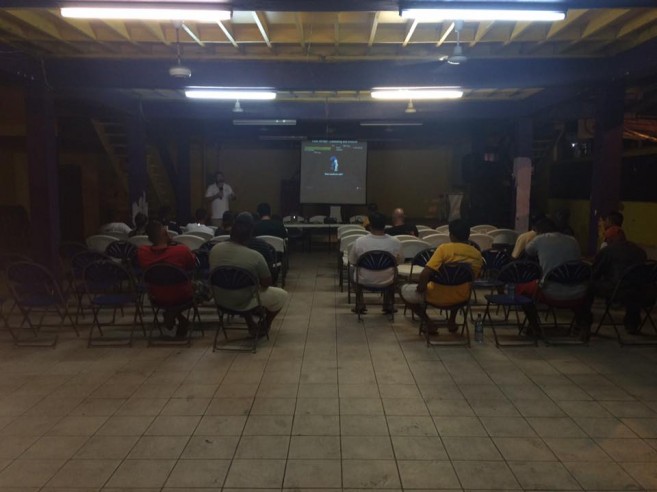The Hyperbaric Chamber adjacent to the Ambergris Hopes Clinic conducted a valuable presentation to several dive instructors on the island on Wednesday, May 25th. Held at the San Pedro Lions Den, the lecture covered two important topics: Guidance on case reviews which dealt with identifying dive related injuries and marine life toxinology. Attendees learned much about the different poisonous marine species they are exposed to every time they go to sea.
Leading the presentation was Director of Medical Programs Matias Nochetto of Diver Alert Networks (DAN) who explained about the importance of knowing the different symptoms a patient may develop during and after a diving session. “It is important to be able to recognize when someone has decompression illness and when the patient does not,” said Nochetto. Putting a patient inside a chamber without knowing exactly what is wrong can be damaging. For example, if someone has punctured lungs, placing him inside the chamber, can be fatal.” Nochetto indicated that when air is leaking from the lungs, it can be noticeable in certain areas of the body, as air bubbles would appear underneath the surface of the skin. Another important observation to keep in mind, according to Nochetto, is to know under which conditions the diver became ill. This includes the length of diving, the depth, and the experience of the individual in this water sport.
The lecture also spoke at length of Marine Toxinology. According to the presenter, even though the sea is an immense place full with natural beauty, it also contains poisonous organisms that may not look harmful. Nochetto pointed out the different culprits divers should try and stay away from, and what different treatments they should apply to their guests in case they have an encounter with one of these poisonous creatures. “Depending on the poisonous creature, you should know how fast your guest will need to be treated and in the worst case scenario evacuated to the nearest medical centre,” he said. “A traditional method used when being stung by a poisonous animal is to let the wound bleed, so some of the venom can be drain out. Applying heat to the affected area helps before an anti-venom can be applied. It is important to know what to do, identify what type of creature it is, what assistance can be rendered onsite, and at the same time provide the doctors at the medical centre with information on the marine creature so they can also be informed of the type of venom the person has been infected with.” Nochetto added that Lionfish are some of the least poisonous marine creatures divers should be concerned of. “Besides the Lionfish, Scorpion fish and jelly fishes, the stonefish is what everyone should avoid at all costs. This fish is very dangerous and its venom is even fatal to humans,” said Nochetto. It is hard to see this fish and swimmers may not notice it, leading to inadvertently stepping on one of them, which will then trigger a sting. The amount of venom injected into the victim will be proportional to the amount of pressure applied to it.
It is recommended that dive instructors always be well acquainted with the different marine life in and around the areas they usually take their guests for diving. By familiarizing themselves with the surroundings, they will minimize the risk of a painful encounter with one of these dangerous marine creatures.
The chamber is located next to Ambergris Hopes Clinic, and operated by Dr. Daniel Gonzalez, one of the few certified doctors in diving medicine in the country.
In times of emergencies, the first point of contact suggested is DAN’s hotline which is +1-919-648-9111 which will provide the appropriate information and advice on what to do, and alert the personnel at the chamber for a quick response. For emergencies, the Hyperbaric Chamber in San Pedro can be also contacted directly at 226-2660.

Share
Read more

